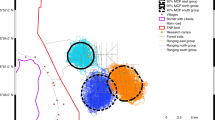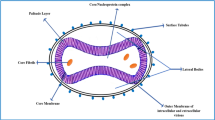Abstract
Experimental studies have suggested a larger inoculum of monkeypox virus may be associated with increased rash severity; however, little data are available on the relationship between specific animal exposures and rash severity in endemic regions. Using cross-sectional data from an active surveillance program conducted between 2005 and 2007 in the Sankuru Province of the Democratic Republic of the Congo, we explored the possible relationship between rash severity and exposures to rodents and non-human primates among confirmed MPX cases. Among the 223 PCR-confirmed MPX cases identified during active surveillance, the majority of cases (n = 149) presented with mild rash (5–100 lesions) and 33% had a more serious presentation (> 100 lesions). No association between exposure to rodents and rash severity was found in the multivariable analysis. Those that self-reported hunting NHP 3 weeks prior to onset of MPX symptoms had 2.78 times the odds of severe rash than those that did not report such exposure (95% CI: 1.18, 6.58). This study provides a preliminary step in understanding the association between animal exposure and rash severity and demonstrates correlation with exposure to NHPs and human MPX presentation. Additional research exploring the relationship between rash severity and NHPs is warranted.

Similar content being viewed by others
References
Aghokeng AF, Ayouba A, Mpoudi-Ngole E, Loul S, Liegeois F, Delaporte E, Peeters M (2010) Extensive survey on the prevalence and genetic diversity of SIVs in primate bushmeat provides insights into risks for potential new cross-species transmissions. Infection, Genetics and Evolution 10:386–396
Arita I, Jezek Z, Khodakevich L, Ruti K (1985) Human monkeypox: a newly emerged orthopoxvirus zoonosis in the tropical rain forests of Africa. The American Journal of Tropical Medicine and Hygiene 34:781–789
Breman JG, Kalisa-Ruti MV, Zanotto E, Gromyko AI, Arita I (1980) Human monkeypox, 1970–79. Bulletin of the World Health Organization 58:165–182
Calvignac-Spencer S, Adjogoua EV, Akoua-Koffi C, Hedemann C, Schubert G, Ellerbrok H, Leendertz SA, Pauli G, Leendertz FH (2012) Origin of human T-lymphotropic virus type 1 in rural Cote d’Ivoire. Emerging Infectious Diseases 18:830–833
Damon IK (2011) Status of human monkeypox: clinical disease, epidemiology and research. Vaccine 29:D54–D59
Di Giulio, D.B., and P.B. Eckburg (2004) Human monkeypox: an emerging zoonosis. Lancet Infectious Diseases 4:15–25
Edghill-Smith Y, Golding H, Manischewitz J, King LR, Scott D, Bray M, Nalca A, Hooper JW, Whitehouse CA, Schmitz JE, Reimann KA (2005) Smallpox vaccine-induced antibodies are necessary and sufficient for protection against monkeypox virus. Nature Medicine 11:740–747
Essbauer S, Pfeffer M, Meyer H (2010) Zoonotic poxviruses. Veterinary Microbiology 140:229–236
Gessain A, Rua R, Betsem E, Turpin J, Mahieux R (2013) HTLV-3/4 and simian foamy retroviruses in humans: discovery, epidemiology, cross-species transmission and molecular virology. Virology 435:187–199
Huhn GD, Bauer AM, Yorita K, Graham MB, Sejvar J, Likos A, Damon IK, Reynolds MG, Kuehnert MJ (2005) Clinical characteristics of human monkeypox, and risk factors for severe disease. Clinical Infectious Diseases 41:1742–1751.
Hutson CL, Carroll DS, Gallardo-Romero N, Weiss S, Clemmons C, Hughes CM, Salzer JS, Olson VA, Abel J, Karem KL, Damon IK (2011) Monkeypox disease transmission in an experimental setting: prairie dog animal model. PLoS One 6:e28295
Hutson CL, Gallardo-Romero N, Carroll DS, Clemmons C, Salzer JS, Nagy T, Hughes CM, Olson VA, Karem KL, Damon IK (2013) Transmissibility of the monkeypox virus clades via respiratory transmission: investigation using the prairie dog-monkeypox virus challenge system. PLoS One 8:12
Jezek Z, Arita I, Mutombo M, Dunn C, Nakano JH, Szczeniowski M (1986a) Four generations of probable person-to-person transmission of human monkeypox. American Journal of Epidemiology 123:1004–1012.
Jezek Z, Fenner F (1988) Human monkeypox. In: Jezek Z, Fenner, F (editors) Monographs in virology, vol 17. Basel, New York, NY: S. Karger Ag. Illus. Maps
Jezek Z, Grab B, Szczeniowski M, Paluku KM, Mutombo M (1988a) Clinico-epidemiological features of monkeypox patients with an animal or human source of infection. Bulletin of the World Health Organization 66:459–464
Jezek Z, Grab B, Szczeniowski MV, Paluku KM, Mutombo M (1988b) Human monkeypox—secondary attack rates. Bulletin of the World Health Organization 66:465–470
Jezek Z, Marennikova SS, Mutumbo M, Nakano JH, Paluku KM, Szczeniowski M (1986b) Human monkeypox: a study of 2,510 contacts of 214 patients. Journal of Infectious Diseases 154:551–555
Jezek Z, Nakano JH, Arita I, Mutombo M, Szczeniowski M, Dunn C (1987a) Serological survey for human monkeypox infections in a selected population in Zaire. The Journal of Tropical Medicine and Hygiene 90:31–38.
Khodakevich L, Jezek Z, Kinzanzka K (1986) Isolation of monkeypox virus from wild squirrel infected in nature. Lancet 1:98–99
Khodakevich L, Jezek Z, Messinger D (1988) Monkeypox virus: ecology and public health significance. Bulletin of the World Health Organization 66:747–752
Khodakevich L, Szczeniowski M, Jezek Z, Marennikova S, Nakano J, Messinger D (1987a) The role of squirrels in sustaining monkeypox virus transmission. Tropical and Geographical Medicine 39:115–122
Khodakevich L, Szczeniowski M, Jezek Z, Marennikova S, Nakano J, Meier F (1987b) Monkeypox virus in relation to the ecological features surrounding human settlements in Bumba zone, Zaire. Tropical and Geographical Medicine 39:56–63
Kulesh DA, Baker RO, Loveless BM, Norwood D, Zwiers SH, Mucker E, Hartmann C, Herrera R, Miller D, Christensen D, Wasieloski Jr. LP, Huggins J, Jahrling PB (2004a) Smallpox and pan-orthopox virus detection by real-time 3′-minor groove binder TaqMan assays on the roche LightCycler and the Cepheid smart Cycler platforms. Journal of Clinical Microbiology 42:601–609
Kulesh DA, Loveless BM, Norwood D, Garrison J, Whitehouse CA, Hartmann C, Mucker E, Miller D, Wasieloski Jr LP, Huggins J, Huhn G, Miser LL, Imig C, Martinez M, Larsen T, Rossi CA, Ludwig GV (2004b) Monkeypox virus detection in rodents using real-time 3′-minor groove binder TaqMan assays on the Roche LightCycler. Laboratory Investigation 84:1200–1208
Likos AM, Sammons SA, Olson VA, Frace AM, Li Y, Olsen-Rasmussen M, Davidson W, Galloway R, Khristova ML, Reynolds MG, Zhao H, Carroll DS, Curns A, Formenty P, Esposito JJ, Regnery RL, Damon IK (2005) A tale of two clades: monkeypox viruses. Journal of General Virology 86:2661–2672
Locatelli S, Peeters M (2012) Cross-species transmission of simian retroviruses: how and why they could lead to the emergence of new diseases in the human population. AIDS 26:659–673
Mucker EM, Chapman J, Huzella LM, Huggins JW, Shamblin J, Robinson CG, Hensley LE (2015) Susceptibility of marmosets (Callithrix jacchus) to monkeypox virus: a low dose prospective model for monkeypox and smallpox disease. PLoS One 10:e0131742
Nolen LD, Osadebe L, Katomba J, Likofata J, Mukadi D, Monroe B, Doty J, Hughes CM, Kabamba J, Malekani J, Bomponda PL, Kebela-Ilunga B, Nikawa F, Pukuta E, Karhemere S, Muyembe JJ, Nguete B, Okitolonda E, McCollum AM, Reynolds MG (2016) Extended human-to-human transmission during monkeypox outbreak in the Democratic Republic of the Congo. Emerging Infectious Diseases 22:1014–1021
Olson VA, Laue T, Laker MT, Babkin IV, Drosten C, Shchelkunov SN, Niedrig M, Damon IK, Meyer H (2004) Real-time PCR system for detection of orthopoxviruses and simultaneous identification of smallpox virus. Journal of Clinical Microbiology 42:1940–1946
Paige SB, Frost SD, Gibson MA, Jones JH, Shankar A, Switzer WM, Ting N, Goldberg TL (2014) Beyond bushmeat: animal contact, injury, and zoonotic disease risk in Western Uganda. EcoHealth 11:534–543
Peeters M, Courgnaud V, Abela B, Auzel P, Pourrut X, Bibollet-Ruche F, Loul S, Liegeois F, Butel C, Koulagna D Mpoudi-Ngole E, Shaw GM, Hahn BH, Delaporte E (2002) Risk to human health from a plethora of simian immunodeficiency viruses in primate bushmeat. Emerging Infectious Diseases 8:451–457
Radonić A, Metzger S, Dabrowski PW, Couacy-Hymann E, Schuenadel L, Kurth A, Mätz-Rensing K, Boesch C, Leendertz FH, Nitsche A (2014) Fatal monkeypox in wild-living sooty mangabey, Cote d’Ivoire, 2012. Emerging Infectious Diseases 20:1009
Reynolds MG, Yorita KL, Kuehnert MJ, Davidson WB, Huhn GD, Holman RC, Damon IK (2006a) Clinical manifestations of human monkeypox influenced by route of infection. The Journal of Infectious Diseases 194:773–780
Reynolds MG, Yorita KL, Kuehnert MJ, Davidson WB, Huhn GD, Holman RC, Damon IK (2006b) Clinical manifestations of human monkeypox influenced by route of infection. Journal of Infectious Diseases 194:773–780
Rimoin AW, Mulembakani PM, Johnston SC, Smith JO, Kisalu NK, Kinkela TL, Blumberg S, Thomassen HA, Pike BL, Fair JN, Wolfe ND, Shongo RL, Graham BS, Formenty P, Okitolonda E, Hensley LE, Meyer H, Wright LL, Muyembe JJ (2010a) Major increase in human monkeypox incidence 30 years after smallpox vaccination campaigns cease in the Democratic Republic of Congo. Proceedings of the National Academy of Sciences of the United States of America 107:16262–16267
Rimoin AW, Alfonso VH, Hoff NA, Doshi RH, Mulembakani P, Kisalu NK, Muyembe JJ, Okitolonda EW, Wright LL (2017) Human exposure to wild animals in the Sankuru province of the Democratic Republic of the Congo. Ecohealth 14:552–563
Rimoin AW, Kisalu N, Kebela-Ilunga B, Mukaba T, Wright LL, Formenty P, Wolfe ND, Shongo RL, Tshioko F, Okitolonda E, Muyembe JJ, Ryder RW, Meyer H (2007) Endemic human monkeypox, democratic Republic of Congo, 2001–2004. Emerging Infectious Diseases 13: 934–937
Rimoin AW, Mulembakani PM, Johnston SC, Smith JO, Kisalu NK, Kinkela TL, Blumberg S, Thomassen HA, Pike BL, Fair JN, Wolfe ND, Shongo RL, Graham BS, Formenty P, Okitolonda E, Hensley LE, Meyer H, Wright LL, Muyembe JJ (2010b) Major increase in human monkeypox incidence 30 years after smallpox vaccination campaigns cease in the Democratic Republic of Congo. Proceedings of the National Academy of Sciences of the United States of America 107:16262–16267
Wolfe ND, Daszak P, Kilpatrick AM, Burke DS (2005) Bushmeat hunting, deforestation, and prediction of zoonotic disease. Emerging Infectious Diseases 11: 1822–1827
Wolfe ND, Switzer WM, Carr JK, Bhullar VB, Shanmugam V, Tamoufe U, Prosser AT, Torimiro JN, Wright A, Mpoudi-Ngole E (2004) Naturally acquired simian retrovirus infections in central African hunters. The Lancet, 363: 932–937
World Health Organization (2016) https://www.who.int/news-room/fact-sheets/detail/monkeypox
Acknowledgements
Many individuals contributed to the design of this manuscript and data collection in the field. We thank the Congolese health workers in the Sankuru District for their surveillance efforts and the DRC Ministry of Health; and the Faucett Catalyst Fund.
Funding
This work was funded by the Eunice Kennedy Shriver National Institute of Child Health and Human Development, Global Network for Women’s and Children’s Health Research; National Institute of Allergy and Infectious Disease, Division of Infectious Diseases and Microbiology.
Author information
Authors and Affiliations
Corresponding author
Rights and permissions
About this article
Cite this article
Doshi, R.H., Alfonso, V.H., Morier, D. et al. Monkeypox Rash Severity and Animal Exposures in the Democratic Republic of the Congo. EcoHealth 17, 64–73 (2020). https://doi.org/10.1007/s10393-019-01459-7
Received:
Accepted:
Published:
Issue Date:
DOI: https://doi.org/10.1007/s10393-019-01459-7




